Disconnect the wiring connectors and harness clamps and remove the wiring protector around the exhaust manifold.
[1.4L]
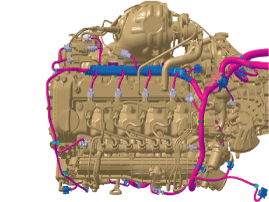
[1.6L]
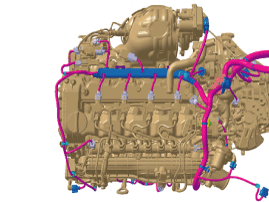
Remove the engine cover.
Disconnect the battery negative terminal.
Disconnect the wiring connectors and harness clamps and remove the wiring protector around the exhaust manifold.
[1.4L]

[1.6L]

Disconnect the air cleaner assembly.
(Refer to Intake and Exhaust System - "Air Cleaner")
Disconnect the brake booster vacuum hose (A).
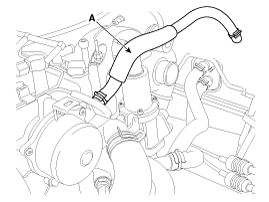
Disconnect the wiring mounting bracket (A), the glow plug connector (B), the lambda sensor (C) and the exhaust gas temperature sensor connector (D).
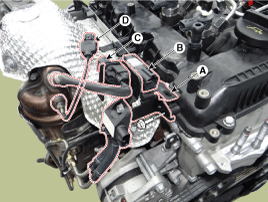
Remove the heat protector (A).
Tightening torque :
14.7 ~ 19.6 N.m (1.5 ~ 2.0 kgf.m, 10.8 ~ 14.5 lb-ft)

Remove the front muffler.
(Refer to Intake and Exhaust System - "Muffler")
Remove the intercooler inlet hose & pipe.
(Refer to Intake And Exhaust System - “Intercooler”)
Remove the DPF converter brackets (A).
Tightening torque :
49.0 ~ 63.7 N.m (5.0 ~ 6.5 kgf.m, 36.2 ~ 47.0 lb-ft)



Detach the DPF converter (A) from the turbocharger.
Tightening torque :
49.0 ~ 63.7 N.m (5.0 ~ 6.5 kgf.m, 36.2 ~ 47.0 lb-ft)
[1.4L]
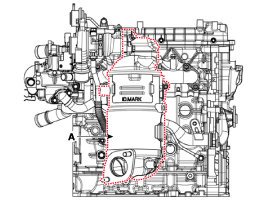
[1.6L]

Remove the oil return pipe (A) from the cylinder block.
Tightening torque :
Bolts (B) : 9.8 ~ 14.7 N.m (1.0 ~ 1.5kgf.m, 7.2 ~ 10.9 lb-ft)
Nuts (C) : 14.7 ~ 19.6 N.m (1.5 ~ 2.0kgf.m, 10.9 ~ 14.5 lb-ft)

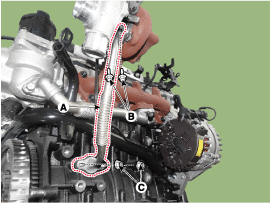
Remove the oil feed pipe (A)
Tightening torque :
Eye bolts (B) : 13.7 ~ 18.6 N.m (1.4 ~ 1.9 kgf.m, 10.1 ~ 13.7 lb-ft)
Mounting bolt (C) : 7.8 ~ 9.8 N.m (0.8 ~ 1.0 kgf.m, 5.8 ~ 7.2 lb-ft)
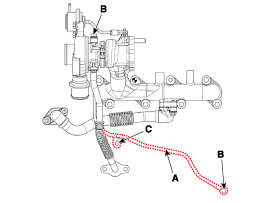
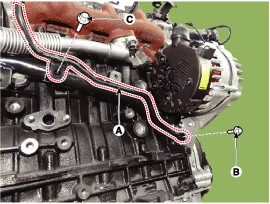
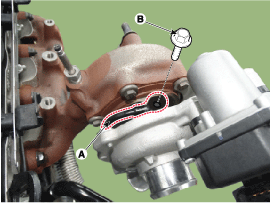
Remove the EGR cooler pipe (A).
Tightening torque :
21.6 ~ 27.5 N.m (2.2 ~ 2.8 kgf.m, 15.9 ~ 20.3 lb-ft)

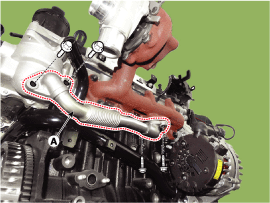
Remove the turbocharger & exhaust manifold (A) with the gasket (B).
Tightening torque :
29.4 ~ 34.3 N.m (3.3 ~ 3.5 kgf.m, 21.7 ~ 25.3 lb-ft)


When installing, replace with new gaskets.
Install in the reverse order of removal.
If any problem related with turbocharger, such as lack of engine power, poor acceleration, abnormal engine noise or oil leaks, may occur, check the turbocharger according to the procedure as follows.
Check the assembly of the turbocharger and the exhaust fitting (or the after treatment).
Check that a gasket is installed.
Check that mounting bolts (or nuts) are tightened properly.
Check for gas leakage.
Check for any damage, such as crack, on the parts.
Gas leakage caused by lack of gasket or inadequately tightened mounting bolts (or nuts) may cause abnormal engine noise.
If the cause of the problem is detected, retighten the mounting bolts (or nuts) to the specified torque or replace the gasket or damaged parts with new ones if necessary.
Check the assembly of the turbocharger and the exhaust manifold.
Check that a gasket is installed.
Check that the mounting bolts (or nuts) are tightened properly.
Check for gas leakage.
Check for any damage, such as crack, on the parts.
Gas leakage caused by lack of gasket or inadequately tightened mounting bolts (or nuts) may cause abnormal engine noise.
If the cause of the problem is detected, retighten the mounting bolts (or nuts) to the specified torque or replace the gasket or damaged parts with new ones if necessary.
Check the assembly of the exhaust manifold and the cylinder head.
Check that a gasket is installed.
Check that the mounting bolts (or nuts) are tightened properly.
Check for gas leakage.
Gas leakage caused by lack of gasket or inadequately tightened mounting bolts (or nuts) may cause abnormal engine noise.
If the cause of the problem is detected, retighten the mounting bolts (or nuts) to the specified torque or install a new gasket if necessary.
Check the turbocharger oil feed pipe & hose and oil drain pipe & hose.
Check that a gasket is installed.
Check that the mounting bolts are tightened properly.
Check that the clamps are positioned in place.
Check for any damage on oil pipes & hoses (bent, crushed, torn or cracked).
Gas leakage caused by lack of gasket or inadequately tightened mounting bolts may cause oil leakage.
If the oil feed pipe & hose are damaged, engine oil may not be supplied sufficiently to the turbocharger and may damage the turbocharger. If the oil drain pipe & hose are damaged and clogged, engine oil may not drain smoothly causing oil leakage from the turbocharger.
If the cause of the problem is detected, retighten the mounting bolts (or nuts) to the specified torque or replace the gasket or damaged parts with new ones if necessary.
Check for oil leakage between center housing and compressor housing.
Check that the mounting bolts are tightened properly.
Check for oil leakage.
If the O-ring (gasket) between the center housing and the compressor housing is damaged, it may cause oil leaks.
If an oil leak is detected, replace the turbocharger with a new one.
Check the turbocharger actuator vacuum hoses & pipes.
Check that the vacuum hose is connected to the actuator properly.
Check if the vacuum hoses & pipes are damaged (bent, detached or torn).
Check for any damage, such as crack, on the vacuum pipes.
Check that the vacuum hoses are connected to inlet or outlet of the solenoid valve correctly.
If the vacuum pipes & hoses are damaged or disconnected, the actuator will not work properly causing lack of engine power or poor acceleration.
If the vacuum hoses & pipes are damaged, replace them with new ones.
Check the turbocharger actuator.
Vacuum type actuator [1.4 L] : Check for movement of the actuator rod when a vacuum of 95kPa (713mmHg, 13.8psi) is applied to the actuator or a forced actuator operating mode is performed by GDS. (Refer to DTC guide)

Electronic actuator [1.6 L] : Check for movement of the actuator rod when a forced actuator operating mode is performed by GDS. (Refer to DTC guide)
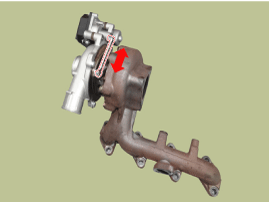
Damaged turbocharger actuator may cause lack of engine power and poor acceleration.
If the actuator rod does not move, replace the turbocharger with a new one.
Check the turbocharger compressor wheel.
Check if the compressor wheel is damaged (bent or deformed).
Check that the compressor wheel rotates smoothly.
e.g.
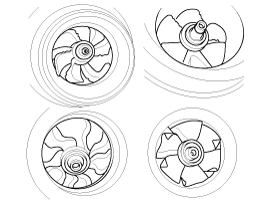
Damaged compressor may cause abnormal noise from the turbocharger and poor acceleration.
If the compressor wheel are damaged or deformed, replace the turbocharger with new ones.
Check the turbocharger turbine wheel.
Check if the turbine wheel is damaged.
Check that the turbine wheel rotates smoothly.
e.g.
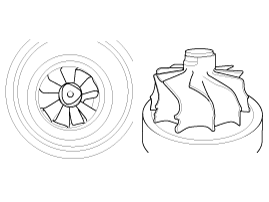
Damaged turbine wheel may cause abnormal noise from the turbocharger and poor acceleration.
If the turbine wheel are damaged or deformed, replace the turbocharger with new ones.
If no problem is detected from the turbocharger, check the turbocharger-related parts according to the procedure as follows.
Check the blow-by hose.
Check if the breather hose is damaged (bent, clogged).
If the breather hose is bent or clogged, the internal pressure in the engine will increase and engine oil will not be supplied smoothly to the turbocharger, causing damage to the turbocharger and oil leakage.
If the cause of the problem is detected, replace the breather hose or the related parts with new ones.
Check the air intake hose connected to the turbocharger.
Check if the air intake hose is damaged (bent, crushed, detached or torn).
If the cross-section of the hose diminishes as the air intake hose is bent or crushed, intake air to the turbocharger will be reduced and the pressure in front of turbocharger will drop, causing damage to the turbocharger or oil leakage. If the air intake hose is detached or torn, foreign substances may go into the turbocharger causing damage to it.
If the air intake hose is damaged, replace it with a new one.
Check the air cleaner.
Check the air cleaner filter for pollution state.
Check the air cleaner filter for water influx.
Check the air cleaner cover for dirtiness.
Check that the air cleaner filter is a genuine part.
If the air cleaner filter is moistened or polluted excessively or a non-genuine part is used, intake air to the turbocharger will be reduced and the pressure in front of turbocharger will drop, causing damage to the turbocharger and oil leakage.
If the air cleaner filter is moistened or polluted excessively, replace it with a new one.
Replace the air cleaner filter according to the maintenance schedule.
Check the intercooler hoses & pipes.
Check that the intercooler hoses & pipes are connected properly.
Check if the intercooler hoses & pipes are damaged (bent, detached or torn).
Check for any damage, such as crack, on the intercooler pipes.
Check that the clamps are positioned in place.
If the intercooler hoses & pipes are damaged or disconnected, oil leakage may occur from the hoses & pipes and the turbocharger may exceed the permissible speed causing damage to the turbocharger.
If the intercooler hoses & pipes are damaged, replace them with new ones.
Use new clamps when replacing the hoses & pipes.
Check the intercooler.
Check if the intercooler tubes and tanks are damaged (oil leak or crack).
If the intercooler is damaged, the turbocharger may exceed the permissible speed causing damage to the turbocharger.
If the intercooler is damaged, replace them with a new one.
Use new clamps when replacing the intercooler.
Check the engine oil.
Check the engine oil level.
Check the engine oil for discoloration, water influx and viscosity degradation.
Check the engine oil grade.
If the engine oil level is low, amount of engine oil fed to turbocharger will be reduced causing the bearings in the turbocharger to adhere due to insufficient lubrication and cooling.
If the cause of the problem is detected, add or change engine oil.
Change the engine oil according to the maintenance schedule.
Check the engine oil pressure.
Engine oil pressure: Check the oil pressure using an oil pressure gauge after removing the oil pressure switch on the cylinder block.
Check the engine oil screen in the oil pan if the engine oil level is low. Then check the injectors for gas leakage if foreign substances are accumulated on the oil screen.
If the engine oil level is low, amount of engine oil fed to turbocharger will be reduced causing the bearings in the turbocharger to adhere due to insufficient lubrication and cooling.
If the cause of the problem is detected, add or change engine oil. If foreign substances are accumulated on the oil screen, wash the oil screen and replace the injector’s washer with a new one after checking the injectors for gas leaks. Check the engine oil-related parts, such as oil pump, if necessary.
As the turbocharger rotates at high speed of 100,000 rpm or above, deterioration of engine oil can cause damage to the turbocharger bearings. Check engine oil for discoloration, water influx, viscosity degradation and oil pressure lowering.
Check the injectors, sensors, EGR valve, etc.
(Refer to Engine Control/Fuel System - "Engine Control System")
Check that the injectors operate properly.
Check that the sensors, such as the mass air flow sensor (MAFS), intake air temperature sensor (IATS), and boost pressure sensor (BPS), operate properly.
Check that the exhaust gas recirculation (EGR) valve operates properly.
Improper operation of the injectors, sensors, EGR valve, etc. may cause diminished engine power.
If the cause of the problem is detected, replace the related parts with new ones.